¶ 1 Leave a comment on paragraph 1 0 The primal scene of archival research takes place in a dreary reading room. A researcher sits at her table, inert. An archivist enters, pushing a cart that bears a dozen dusty gray boxes. (See Figure 1.) The archivist unhinges a box, removes a numbered file folder and, placing it at the researcher’s elbow, steps back. The researcher stirs, then sits upright with a mechanical jolt. She turns sharply in the direction of the folder, flips it open and cocks her head towards the flimsy leaves inside; now she is reading. (Zoom in on the eyes as they click into focus.) Now she is reading, and now she truly comes alive; she bends towards the papers, taps her forehead in thought. A sheaf of blank paper and a pencil appear on her table, and she begins taking notes. Her fingers fly—and soon, so do the pages she is writing upon. Caught up in eddies of excitement, they swoop to the ceiling and around the room and down to the floor, where they fall together into perfect piles. Bindings sprout from the outer strata; the pages sew themselves into bright, tight, hard-cover books. These the archivist gathers up and places on the shelves that line the room, next to other books and gray boxes.
¶ 2 Leave a comment on paragraph 2 0
¶ 3 Leave a comment on paragraph 3 0 I may have it backwards: in other versions of the fantasy, it is the archive that is first animated by the presence of the researcher, a Dr. Coppelius who waves a pencil and sets the dusty boxes to dancing. But either way, the archival imaginary posits a symbiotic relationship between researcher and source, a photogenic pas de deux that leads to a finished scholarly product. This work, in turn, enters the archive for the next generation of researchers; it might even be taken apart again so that its secret ingredients (notes, drafts, letters) can themselves be served up in a series of boxes. Such a strangely private form of publication it creates, the coupling of researcher and source.
¶ 4 Leave a comment on paragraph 4 0 What Freudian trauma results from witnessing this sight? Only the harm that myth inflicts. This primal scene is a fiction, a dream of perfect union between researcher and source that ignores, first of all, the full cast of characters. What about the archivist, who is rendered invisible? What about all those within and without the archive, upon whose labor—acquiring, preserving, organizing, reading, cataloging, describing, interpreting, analyzing, debating, teaching, writing, editing, digitizing, referencing and publishing—the current project depends? More a barn dance than a pas de deux: an archival encounter is an enactment of social authorship long before the researcher enters the room.1
¶ 5 Leave a comment on paragraph 5 0 But even a barn dance is much too mannered a metaphor. The sketch above misleads us more generally about the experience on the ground. Doing time in an archive is often tedious, uncomfortable and bewildering. For librarians, there is the struggle to promote and simultaneously protect what you have; the difficulty of fitting unruly materials into arrangements and workflows; and worries about space and time—where to put it all, how to address your backlog. For researchers, there is the struggle to locate the archives you need and what matters to you inside them; the uncertainty created by unruly data; and worries about time and space— how to access what you need during your research trip, how to record and organize the information you gather. At both ends, the archival encounter is counter-cinematic and erratic, days of monotonous sifting and dead-ends punctuated by one or two, or maybe zero, hidden moments of vivid, peculiar joy.
¶ 6 Leave a comment on paragraph 6 0 So archival research does not fulfill its ideal outline. So what? Who cares? Why dredge up the fantasy? Because the fantasy continues to structure our archival encounters—what we expect and undertake in the reading room, what we allow it to mean. Twenty years ago, Alice Kaplan observed that “conventional academic discourse requires that when you write up the results of your archival work, you tell a story about what you found, but not about how you found it. The less the seams of your findings show, the better your discoveries lend themselves to use by others… tell[ing] these stories breaks their spell and violates the spirit of the archives.”2 With a few word changes, the same could be said about what counts as professional archivist discourse: the impersonal, neutral genre of the finding aid, for example, should say what is in a collection, but should not discuss what is confusing or missing in it, or the problems it posed in processing.3 Despite the growing recognition that this sequestration is never completely possible—that the material conditions and social relations of the archive shape the work we do in it—that work continues to be represented in professional and scholarly publications as if it is. Despite the recent call to move to the fore “the backstage of the archives—how they are constructed, policed, experienced, and manipulated” in order to support historiography “not merely [as] a project of fact-retrieval” but as “a set of complex processes of selection, interpretation, and even creative invention,” the “backstage” stays in the background.4 Antoinette Burton may be correct that “many if not most historians operate under the assumption that history is a highly interpretive act,” but this belief is not yet reflected in the archival encounter: the ways that researchers (not just historians) and librarians report their experiences with primary sources; the ways that librarians and researchers work together; the ways librarians and researchers regard the involvement of “non specialists.”5 While the advent of digitization and electronic resource sharing has revolutionized the research landscape, making primary sources public in unprecedented ways, there remains in the archive a habitus of secret knowledge—the “spell” that Kaplan is loathe to break. This is not necessarily intentional. It is rather the effect of layering recent shifts in technology, theory and professional definition onto older foundations: petrified conditions, relations, expectations and systems that continue to operate in part through the enduring power of fantasies about research. What we have in the archive is a stratified groundwork that still governs our archival encounters.
¶ 7 Leave a comment on paragraph 7 0 But, you will object, the archive has already changed. Now we have the “archival turn”—the scholarly interest in the archive not just as a source of evidence but as an epistemological mode. Surely, this attention to the constructedness of the archive has led to a revealing reconsideration of what actually goes on inside an archive; surely, as a result, those archaic fantasies have diminished. Have they? In what follows, I begin by unearthing one stratum of the archival turn, the decade of the 1990s, as represented by three texts: Kaplan’s essay mentioned above, “Working in the Archives” (1990). (See Figure 2.)
-
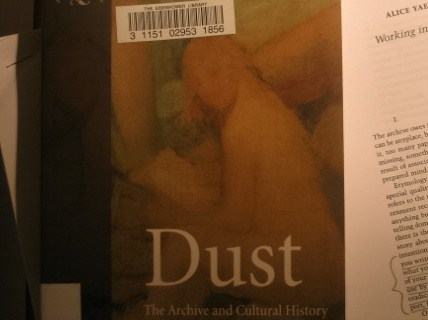 Library copy of Carolyn Steedman’s Dust.6
Library copy of Carolyn Steedman’s Dust.6 -
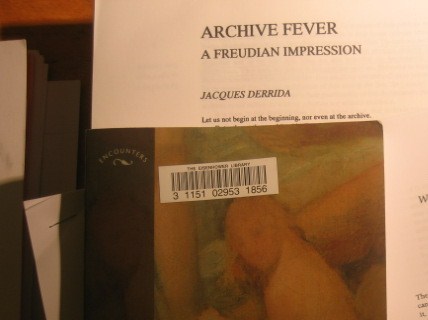 Print out of Jacque Derrida’s “Archive Fever” from Diacritics.; and Carolyn Steedman’s Dust: The Archive and Cultural History (2001).
Print out of Jacque Derrida’s “Archive Fever” from Diacritics.; and Carolyn Steedman’s Dust: The Archive and Cultural History (2001). -
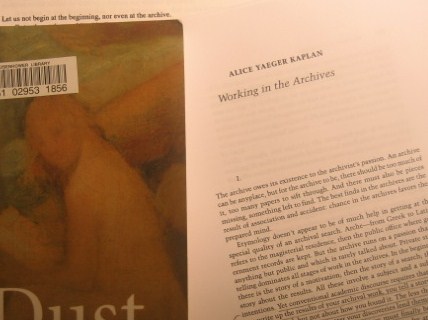 Photocopy of Alice Yaeger Kaplan’s “Working in the Archives.”
Photocopy of Alice Yaeger Kaplan’s “Working in the Archives.”
¶ 9 Leave a comment on paragraph 9 0 A cross-examination of these three texts reveals a pattern of interests, a set of efforts to defy customary practices—but only, it turns out, “in theory.” While certain practices are challenged in these texts, they leave mostly intact the older strata of archival research fantasies and conventions. Kaplan, Derrida and Steedman do not dislodge the forces that organize the actual archival encounter.
¶ 10 Leave a comment on paragraph 10 0 How does this happen? Why is practice so stubborn? We need another take on archival practice: not practice in theory, but practice in action; not the 1990s, but now; not in terms of textual patterns, but in terms that suit the subject: the terms of the archival encounter itself, and the eccentric, anachronistic and even monotonous experience it generates. My second look at practice will take the form of a series of vignettes about a real-life archive, the George Peabody Library in Baltimore. While this narrative structure may seem to recreate the division of labor between theory and practice, my hope is that—by giving practice the last word—we’ll be in a better position to synthesize the two.
¶ 11 Leave a comment on paragraph 11 0 I. “The library doubles as a detective’s office.”7
¶ 12 Leave a comment on paragraph 12 0 The archival turn could be dated to the founding of “scientific” history in the mid-nineteenth century, or to the development a century later of the quantitative methods of the Annales School, or to other evidence-based movements in the history of history, but what is generally meant by this phrase corresponds with the formation of cultural studies and the use of the archive as a conceptual category. That is, the archival turn has to do with the notion of the “figuration” of the archive, a parallel decline in its empirical authority and a related expansion of its relevance within domains that are not exclusively historiographic, like art, literary criticism, textual studies, media studies and information studies.8 But it is not irrelevant that a devotion to archival methods precedes by many decades contemporary theories of the archive; if the archival turn lacks a precise origin, this (we will see) is completely in keeping with its own preoccupations.
¶ 13 Leave a comment on paragraph 13 0 Kaplan therefore represents in some ways an arbitrary beginning for this cross-examination—clearly the archive as a conceptual category predates 1990—but her article does initiate something new: the recognition that there is something called an “archive story” that must remain hidden in order for the official “results” to function authoritatively. In admitting this bit of professional legerdemain, and in telling her own archive story in a prestigious scholarly journal, Kaplan not only commits the violation she prohibits but also contradicts it. Through its publication, Kaplan’s own archive story is elevated to the status of “results”—a kind of research that shadows conventional academic discourse. Indeed, Kaplan notes, such “fables” of research “can be analyzed like a text,” a “mixed up genre” that combines the “redemptive detective fiction” with the epic and the dime novel.9
¶ 14 Leave a comment on paragraph 14 0 Kaplan’s archive story thus marks a distinctive moment in the archival turn—one which gained its most prominent authorization in 1994, with a paper that Jacques Derrida delivered (in English) to a conference sponsored by the Freud Museum, the Courtauld Institute and the Société International d’Histoire de la Psychiatrie et de la Psychoanalyse. Called initially “The Concept of the Archive: A Freudian Impression,” the lecture was revised and published in 1995 as Mal d’archive: une impression freudienne in French; the published English version echoed the French publication with its 1995 title Archive Fever. As Carolyn Steedman points out in Dust: The Archive and Cultural History, however, this work that has been assigned a seminal status in archival studies “for the main part… is not about archives at all, but is rather a sustained contemplation of a work of history, of Yosef Hayim Yerushalmi’s Freud’s Moses: Judaism Terminable and Interminable (1991),” itself a sustained contemplation of Moses and Monotheism—which (according to Steedman) Yerushalmi examines through Freud’s description of the work as a “‘historical novel,’ or a kind of historical story,” undertaken “in order to understand the period of baroque anti-semitism through which he was living.”10
¶ 15 Leave a comment on paragraph 15 0 Dizzy yet? Let’s undertake a more careful reading of this splatter pattern of intra-references—or, to stick with the archaeological metaphor, let’s call them groups of potsherds buried in the 1990s layer of the “archival turn.” Digging down to reassemble them reveals a set of interests with special implications for archival practice.
¶ 16 Leave a comment on paragraph 16 0 The most prominent group of sherds to note are the fragments of disciplinarity: the inter-, multi- or perhaps simply anti-disciplinarity of the texts, authors and audiences caught up in these three archival addresses. Kaplan, an American scholar of French literature, calls the post-theory exchange between literature and history a “cross-pollination of desire between historians and literary critics” undertaken “with the curiosity and energetic passion of collectors.”11 Steedman, a British historian, performs this cross-pollinating process without comment: her epigraph to Dust is from Virginia Woolf’s To the Lighthouse, one chapter treats George Eliot’s Middlemarch in depth… in fact, almost every chapter depends on a literary text.12 Derrida, a French philosopher, produced a work that has been exceptionally mobile across disciplines, forms, languages and professional domains. He gave his initial talk to an audience drawing on three different kinds of institutions; Mal d’Archive was published in book form in both French and English, but also made an intermediate appearance as an essay in the journal diacritics. All of these texts, it seems, respond to the provocations of the archive—to the materials and circumstances of discovery—rather than to the disciplinary distinctions that arguably divide the archive from itself.
¶ 17 Leave a comment on paragraph 17 0 Archive Fever has become a founding document even though, as Steedman notes in the very beginning of her book, many in Derrida’s audience “knew the ‘archival turn’ to be [already] well underway” at the time of his talk.13 As it happens—and this is the second group of sherds I see—these three essays have in common an investment in or a problem with origins, especially with the failure of origins. Derrida, for example, defines archive fever as a kind of Freudian death drive—a drive to fix and preserve which at the same time “works to destroy the archive: on the condition of effacing but also with a view to effacing its own ‘proper’ traces… [it] is above all anarchivic, one could say, or archiviolithic… the archive always works, and a priori, against itself.”14 If the archival impulse is driven to destroy its own work, then the question of origins ultimately point to the larger question of disorder. The disorder of origins makes frequent appearances in the essay but one example will make the point—in the “Preamble” where he recounts how he titled the talk that he had not yet written and was to give at the Freud Museum. The “Preamble” starts with his reflections on the word “impression,” which has several simultaneous registers of meaning for him. One of these is the “scriptural or typographic” register: that of the graphic impression that marks a substrate. In English, “impression” is phonetically related to “repression” and “suppression,” key words in the Freudian vocabulary, translated respectively from the German Verdrängung and Unterdrückung. English, that is, retains the rhyming relationship of the two German terms, and “impression” in this company comes to have a vaguely Freudian meaning as well. But in French, Verdrängung is “refoulement,” which means something more like expulsion, a driving away. The Freudian sense of the French word “répression” has been reserved for Unterdrückung. So English “repression” defines a phenomenon that must be distinguished from the French “répression.” These translational shifts “directly concern the structures of archivization,” Derrida says, “because they touch on the topic differences and thus on the location of the substrates of traces” (Derrida, 23). In other words, how do you classify concepts whose meanings shift across languages? Where do you store them in a disciplinary grammar—or in an archive? How do these asymmetrical linguistic structures shape the establishment and extension of a new science? For Derrida, the difference between “repression” and “répression” is “enough to disrupt the tranquil landscape of all historical knowledge, of all historiography, and even of all self-consistent ‘scholarship’”15
¶ 18 Leave a comment on paragraph 18 0 Origin failure appears both as deliberate performance and as unintentional oversight in these essays. Derrida stages his own inability to get past “go”; with an introductory section, and subsequent sections sub-titled “Exergue,” “Preamble,” “Foreword,” his essay functions, Steedman notes, like a “primer offering instruction in the principle of deferral.”16 For all her insight into Derrida’s titling adventures, however, Steedman’s title is marked by its own origin aporia. While her first chapter is devoted to Archive Fever—a “let’s begin at the beginning” homage to the seminal text—her book’s title, Dust, seems more indebted to the last sentence of Kaplan’s essay, published five years before Derrida’s: “Usually there is no mother lode, no original manuscript to be retrieved—the gold is all in the dust.”17 Kaplan, however, is never mentioned.18
¶ 19
Leave a comment on paragraph 19 0
 Figure 3. Website for the Centre de documentation juive contemporain.
Figure 3. Website for the Centre de documentation juive contemporain.
¶ 20 Leave a comment on paragraph 20 0 Kaplan, for her part, unravels her own archive story. She gives us a kind of “whodunit”—her search for the ephemeral sources of Louis-Ferdinand Céline’s anti-semitic pamphlet Bagatelles pour un massacre (1937). She uses this account to exemplify her effort to “move through the archival process and recover some of the stories that get deleted in the final scholarly form.”19 These beginnings are preemptively struck out, however, by what seems to be her main claim: “the passion of the archives must finally be used to eradicate all personal stories in the interests of the dry archival report, fit for a public.”20 Only in the “para-text”—a preface, for example—can the archive story appear without “interrupt[ing] or complicat[ing] the narrative so much that no results could ever be understood or perceived.”21 Despite this unequivocal assertion, the personal “whodunit” prevails in her essay, especially in the final section set in the Centre du documentation juive contemporain (CDJC). It is this library, where Kaplan solves the mystery of Céline’s sources, that “doubles as a detective’s office.”
¶ 21 Leave a comment on paragraph 21 0 While Kaplan’s research mystery resolves neatly, the truth about archives is that they are full of gaps, mistakes and excesses: in the words of one of the CDJC librarians, “‘ici on trouve tout’—there’s some of everything here”—but not, one could add, all of anything.22 Kaplan’s essay ends by nullifying both her detective story success and her “dry archival report,” by recognizing the disorder on which both of these narratives are unsteadily perched: “The archive is constituted by these errors, these pieces out of place, which are then reintegrated into a story of some kind.”23 “A story of some kind”? So much for “results.”
¶ 22 Leave a comment on paragraph 22 0 Kaplan sets us up to perceive one final potsherd pattern common to these three essays. If origin-less disorder is the order of the archive, it is a disorder that is generated out of human loss—a disorder that joins the body and the material world. The archive is always predicated on historical violence of some sort, whatever is censored, erased, excluded, trumped up, used up, misplaced, conquered, killed. Moreover, the archival categories that mark both the visible victories and hidden defeats do not stay within their walls; the archive is both a repository of existing schemas and a means of perpetuating them in the world beyond. While we might usually think of this disciplinary activity as a pact between the archive and its political authors, Steedman makes it clear that the dilemmas of order shape the archival body in many ways. For example, she takes literally the provocation of Derrida’s title Archive Fever to investigate the illness that researchers contract on the penultimate day of their trip to the archive: prompted by the anxiety of the task that remains unfinished, they end their research with night-sweats and head-aches. But what seems like a strangely specific malady is transformed by Steedman into a far-reaching social symptom: by relating the researcher’s “archive fever” to the terrible diseases suffered by tanners, skinners and other workers in the trades associated with paper and leather, Steedman expands our sense of who is in the archive—the bodies whose specialized labors populate our libraries with books, the many kinds of expertise the archive consumes.
¶ 23 Leave a comment on paragraph 23 0 For Derrida, the relation between the material archive and its human architects focuses on one kind of “graphic mark,” a particular “private inscription”: circumcision as the archival signature that is also the signature of patrimoine, with Freud’s relationship to his father as his main example.24 It is perhaps not a coincidence that the body in question in both Kaplan’s and Derrida’s archive is Jewish, for that is a body that has come to symbolize the destructive power of classificatory regimes. Despite her contention that the private passions motivating research must be kept secret, Kaplan is fascinated by the “missing person stories” at the CDJC: by the “quantity of people who are there for personal reasons,” the survivors of occupation or deportation or camps, or their descendants, quietly looking up their lost ones or noisily dropping off their memoirs.25 This disorganized crowd of dead and living bodies tries to meet up with an equally disorganized crowd of materials—individual letters, trial transcripts, pamphlets, newspapers, first-person accounts, books, photographs, lists. The monumental task of match-making, the librarians’ work, is never complete. More papers are always generated or declassified or discovered, different human questions and needs emerge. The tidy choreography of the research fantasy, where the detective always finds her man, is not so much in evidence; what we have instead is corpora in excess of existing categories.
¶ 24 Leave a comment on paragraph 24 0 Kaplan, Derrida and Steedman open up the archival body. They show us how paper meets the press of flesh; they make us feel just how intimate it is.26 But for all their revelations about the limits of discipline and the multiplicities of disorder in the archive, these texts do not disclose the specific methods of engagement that led to their existence. While Kaplan offers up her own archival victory and outlines several other such stories, she still insists on their marginalization.27 If these texts are not concerned with actual practices in the archive or changes in its methodologies, what do they tell us?
¶ 25 Leave a comment on paragraph 25 0 First, they suggest one reason for the perpetuation of myths about the archive. While Kaplan, Derrida and Steedman are eager to show how archival materials do not conform to disciplinary distinctions—an enthusiasm related to other disruptive tendencies in late twentieth-century humanist scholarship –they seem less cognizant of a related phenomenon: the archive does not obey strict professional divisions, either. In Kaplan’s library-as-detective’s-office metaphor, the scholar is the detective, but does the “Eureka” moment belong only to the scholar who pieces together a narrative? What about the people who prepared those pieces? The archivist is still missing in action. Likewise, these essays do not dwell on missing boxes, illegible papers, neglected citations. There are no descriptions of archival slogging, no admissions that some materials failed to be relevant. And of course, there are no prescriptions for a different order. It is not the main aim of Kaplan, Derrida and Steedman to effect an evolution of practice; archival turnistas are not interested in disorder in order to re-order. But it is worth remembering that it is not in their professional interest as scholars to make their practices more transparent.
¶ 26 Leave a comment on paragraph 26 0 Secondly, along the same lines, these texts inform us of the duplicity of speculative practices that reveal but cannot live out the instability of their archival mandates. Kaplan, Derrida and Steedman are put into the position of saying, “Yes, the archive is biased, idiosyncratic and treacherous—but the observations I draw from it are flawless.”28
¶ 27 Leave a comment on paragraph 27 0 Finally, these texts suggest why archival studies that attempt to be explicit about the messy nature of the archive have become instead “archive studies.” In more recent works like Refiguring the Archive (2002), Archive Stories: Facts, Fictions and the Writing of History (2005) and Along the Archival Grain: Epistemic Anxieties and Colonial Common Sense (2009), the archive appears as a subject in its own right. Although the archival scenarios that are put into play in each of these books incorporate different disciplines—art, history, anthropology, literature, post-colonial studies—they have essentially created a new discipline. “Archive studies” is something we might, in the taxonomy of disciplines, see as the love-child of cultural studies, history and archival methodology. Moreover, this new discipline has in common with other humanities disciplines a complete blindness about its professional investments; it does not register much awareness of the professional investments of librarians, archivists, curators and “non-specialists,” or invite insights from those perspectives. Perhaps this is inevitably what happens when academics must give legitimacy to something new, which in turn reflects the pressures of scholarly communication: a topic must be delineated in conventional terms in order to merit publication.29 But it is also true that in these more recent books, which openly investigate the archive’s power-politics, the disorderly drift of the archive and its hybrid corporeality have mostly been bent towards a particular narrative about the archive as an agent of history rather than as a set of ongoing practices. It is as if the historical archive has been assembled in ways that reflect and reiterate power relations, but the contemporary archive has not; it is as if the researcher’s own research travails remain a transparent layer over the body of work that it constructs.30
¶ 28 Leave a comment on paragraph 28 0 Perhaps it would also be fair to note that, if archival studies are now being formulated as an interdisciplinary discipline called “archive studies,” this might be just another stage in the turn. It might be that what comes next reconfigures the premise of disciplinarity and the promise of disorder, with a different approach to the human/non-human interactions that the archive documents and realizes: a more diffuse and multi-vocal set of practices in place of a new field. One way to imagine this approach would be to fully embrace Kaplan’s idea of the archive story as an account of what one hoped for, looked for and found, what one did and did not do, in the archive—an account loosed from the quarantine she advocates. Some very basic genre precedents for the archive story do exist; the bibliographic essay and the methodology statement, for example, have played an important role in many disciplines in the past and still do in some. Instead of a para-textual nod towards that archive story (in Kaplan’s sense), why not create a parallel text written collaboratively by the researcher(s) and the librarian(s), or by one person acting in both professional capacities, that runs alongside the official “results”? Or in a set of expanded notes that address not just the “what” and “where” but the “how” and “why” of sources, which are lifted from their small-type, bottom-of-page basement up into the light? Or—to add yet another layer—parallel texts that also offer room for exchange with other researchers, archivists and even interested “non specialists,” like collectors, bibliophiles and fans?
¶ 29 Leave a comment on paragraph 29 0 If it is hasn’t been clear already that I have scrupulously avoided so far the other kind of archive, the digital archive, it will be now. What I am imagining would be far too complicated to produce or consult in print, but would not be at all difficult to organize as a digital object—as an archive in its own right. By avoiding the digital archive up to this point, I have also finessed the fact that our current archival research methods are completely reliant on the digital archive, along with the development of online research tools and electronic instruments of data discovery and organization. Those conditions probably bear the most responsibility for making the archive visible as something that warranted a “turn” in the first place. Even Derrida refers in each version of Archive Fever to the computer on which he is currently composing, predicting that email will not only totally transform the archive as he knows it, but will make his own essay obsolete.
¶ 30 Leave a comment on paragraph 30 0 In short, we already have in place both the theory and the media that will make it possible to enact a radical new archival practice. We have in place what we need to integrate the archive story into the archive itself, while making it visible as a new form of “results.”
¶ 31 Leave a comment on paragraph 31 0 II. The library doubles as a librarian’s office.
¶ 32 Leave a comment on paragraph 32 0 I could end here, with a triumphant firing of the starter pistol and a rousing cheer. But that would be a bit disingenuous, given that the starter pistol for both the archival turn and the academic use of the internet actually went off decades ago. So the question remains, what stands in the way of the practical enactment of the archival turn’s speculative insights? I’d like to engage this question by following Kaplan’s example (but not her main claim): through some archive story-telling about the George Peabody Library. These three vignettes, identified as “typical” through conversations with my colleague Paul Espinosa, illustrate the intractable formations that present-day archival encounters come up against.
¶ 33 Leave a comment on paragraph 33 0 1. The Perils of Description.
¶ 34 Leave a comment on paragraph 34 0 A group of Russian speakers visits the Peabody Library. The dozen men and women sit down around the screen that Paul has set up. He narrates a brief slide-show about the Peabody’s history, then leads them to a table where a dozen books from the collection have been laid out in cradles. He tells them about each book: what it is, why it is interesting. Each phrase of his presentation is painstakingly translated by the group’s leader into Russian.
¶ 35 Leave a comment on paragraph 35 0 When academic and community groups visit the Peabody, my colleagues and I draw upon a standard tour-guide’s repertoire to describe it. We explain that George Peabody was a tradesman cum financier cum philanthropist who decided in 1857 that Baltimore needed a cultural institution to support the arts and learning. We talk about the evolution of the Peabody Institute, the four-part athenaeum that resulted, with its art gallery, lecture series, conservatory and free, public, non-circulating library. We discuss the model of philanthropy that George Peabody initiated and its wide-ranging influence. We point out the signal features of the awe-inspiring architecture of the current library, built to accommodate a rapidly growing collection in 1878. But when it comes to the library itself, as a collection, it is hard to know what to say. How to accurately translate the library’s holdings into a succinct and memorable statement that conveys an appropriate level of detail to different audiences? While it poses specific challenges, the Peabody also exemplifies more general problems of collection description.
¶ 36 Leave a comment on paragraph 36 0 We do not lack evidence for the evolving contents of the Peabody. We have the two-volume printed list of “desiderata” drawn up by the Peabody’s first librarian, John G. Morris.31 (See Figure 4.) We have the collections register for several decades’-worth of acquisitions, recording bibliographic information and accession numbers that can still be found on the inside front end papers of many of the books in the collection. We have the librarians’ annual reports to the library trustees.32 We have the library’s first printed catalogue, an unsurpassed achievement when first published in 1883, which listed 100,000 volumes by author and title.33 (See Figure 5.) We have the cards from the Dewey decimal system card catalogue, which replaced the printed catalogue in the 1910s. Now, of course, the library’s collections are represented in an online catalogue that integrates them with other collections in the Hopkins library system.
¶ 37
Leave a comment on paragraph 37 0
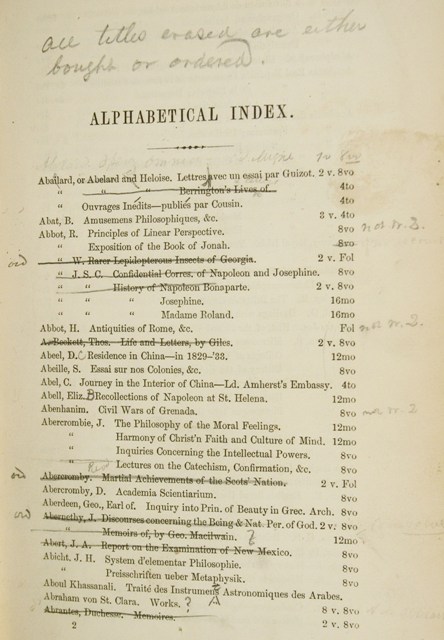 Figure 4. Alphabetical index from Alphabetical Catalogue (“desiderata”).
Figure 4. Alphabetical index from Alphabetical Catalogue (“desiderata”).
¶ 38
Leave a comment on paragraph 38 0
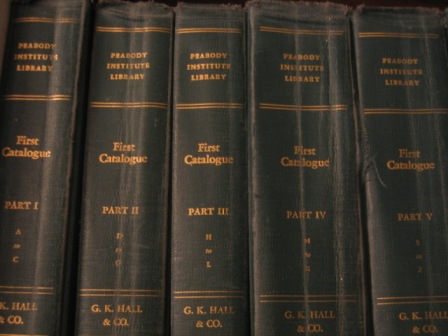 Figure 5. Reprinted volumes of the Catalogue of the Library of the Peabody Institute (1883).
Figure 5. Reprinted volumes of the Catalogue of the Library of the Peabody Institute (1883).
¶ 39
Leave a comment on paragraph 39 0
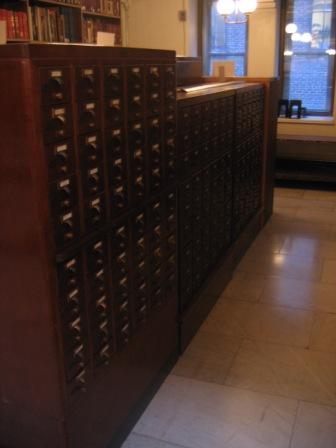 Figure 6. One of two card catalogues in the Peabody.
Figure 6. One of two card catalogues in the Peabody.
¶ 40 Leave a comment on paragraph 40 0 These markers of the collection, however, fail to satisfy some contemporary research queries for reasons that are both practical and philosophical. The transfer of the printed index, organized by author, to the Dewey decimal system, organized by topic, represented a major epistemological shift that facilitated browsing by subject category. But of course, those categories are embedded in historically-bound notions about the subjects and structures of knowledge: Dewey was invented in the 1870s, and the 22 revisions it has undergone since then cannot overcome its essential organizational distortions. For example, the literature range—the 800s—offers only 10% of its categorical space to literatures in languages other than English, Germanic and Romance languages, Greek and Latin.
¶ 41 Leave a comment on paragraph 41 0 In the case of the Peabody, the Dewey arrangements overlay even older systems of knowledge hierarchy. Should we continue to offer, for example, a description of the Peabody’s “voyages and travels” books? This category represents a Renaissance schematic that was still in service in the mid-nineteenth century; while actual “voyages and travels” were extended by colonial ventures, the category was eventually disbanded. Dewey combined it with geography to make a sub-category of “history.” In keeping active the old-fashioned phrase “voyages and travels,” we are participating in a centuries-long project of euphemism about the material aims and actual activities of colonialism; we are privileging an early phase of the Peabody’s evolution over later phases; we may even be confusing modern researchers. And yet, as one of the topics in Morris’s “desiderata,” a considerable portion of the Peabody’s collection was acquired with the aim of fleshing out that descriptor. (See Figure 7.)
¶ 42
Leave a comment on paragraph 42 0
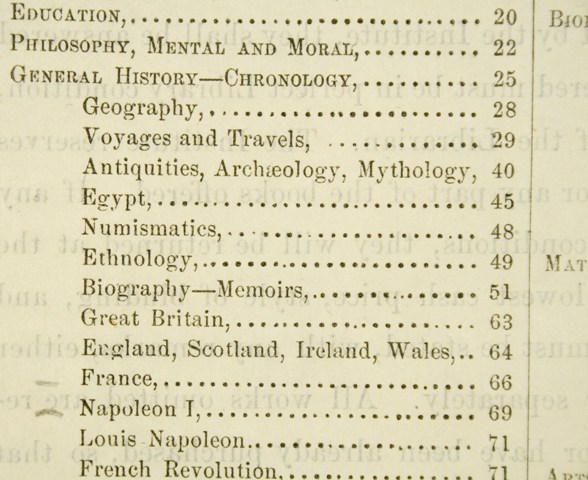 Figure 7. Detail of subject index from Alphabetical Catalouge No. 2 (“desiderata”).
Figure 7. Detail of subject index from Alphabetical Catalouge No. 2 (“desiderata”).
¶ 43
Leave a comment on paragraph 43 0
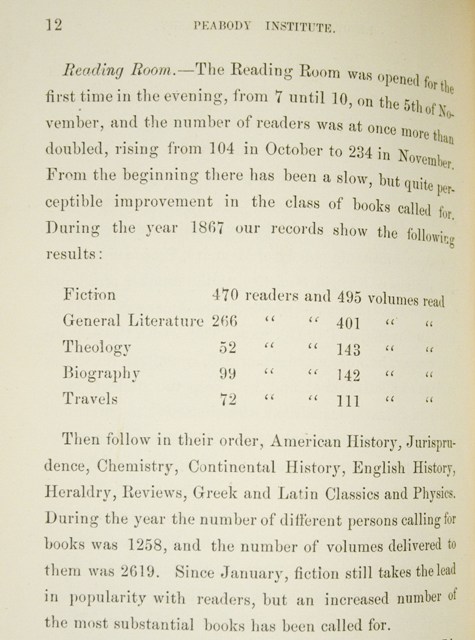 Figure 8. Detail from First Annual Report showing chart of books read, with special mention of fiction.
Figure 8. Detail from First Annual Report showing chart of books read, with special mention of fiction.
¶ 44 Leave a comment on paragraph 44 0 Yet another classificatory dilemma is expressed by George Peabody’s original statement of the library’s purpose: that it “be furnished in every department of knowledge, with the most approved literature… It should consist on the best works on every subject… to satisfy the researches of students who may be engaged in the pursuit of knowledge not ordinarily attainable in the private libraries of the country.”34 The Peabody was founded as a cultural institution for the people of Baltimore, but from the first, this democratic ambition was in conflict with the intellectual aspirations of the first librarians and their desire to facilitate civic “self-improvement.” Morris (a doctor of divinity), his successor Nathaniel Holmes Morison (a schoolmaster and poet), and Morison’s assistant and successor Philip Uhler (who had trained as an entomologist) were all devoted to the nineteenth-century idea of the scholar-librarian. Morison wrote in one annual report that “Education always proceeds from the above downward, from the best to the common minds, from the leaders of the people to the people themselves. Furnish… the foundations of intelligence and thought, and they will… stimulate and improve the whole community.”35 When the Johns Hopkins University was founded in 1876 in close proximity to the Peabody—in large part to take advantage of the library—the tendency of the librarians to address scholarly needs and “approved literature” over popular desires was given additional momentum. In keeping with these ideas, the Peabody’s librarians kept careful track of their readers’ choices, noting with special caution the numbers of novels that were requested.
¶ 45 Leave a comment on paragraph 45 0 This schism at the heart of the library’s collecting paradigm was not unique to the Peabody; the question of reading matter—should it offer leisure for the masses or the means of social uplift?—was central to the public library movement of the second half of the nineteenth century.36
¶ 46 Leave a comment on paragraph 46 0 Finally, the Peabody’s “desiderata” acquisitions and librarians’ selections were supplemented by book donations from local elites—bibliophiles with extensive private collections that included incunabula, classical authors in Renaissance editions, expensive illustrated atlases. At the same time, book donations came in from more plebian sources. The Peabody’s growth overlapped with the decline of the local social libraries, and it eventually absorbed some of the books from the Library Company of Baltimore, Robinson’s Circulating Library and several small professional and mechanics’ libraries. And I haven’t even touched on the Peabody’s twentieth-century fate.
¶ 47 Leave a comment on paragraph 47 0 The variety of philanthropic impulses, resource streams and classification philosophies that have fed the Peabody over the 150 years of its existence has led to a collection that does not so much map the nineteenth-century mind as signal its odd amalgam of popular and scholarly investments. The Peabody’s collection effectively evades succinct description—at least, any kind of description that pretends to be coherent, that is not perforated by its stakes in local history, library history, book history. But more importantly, it suggests the degree to which accident and opportunity and prejudice and wealth and the changing winds of cataloguing rules shape any archive. Description, which should be the most fundamental tool of communication between librarians and researchers, turns out to be utterly elusive. Yet we do not know what to replace them with, these inadequate descriptions, these exercises in stilted and partial translation.
¶ 48 Leave a comment on paragraph 48 0 2. The Researcher’s Progress.
¶ 49 Leave a comment on paragraph 49 0 I am preparing for my class about women and nineteenth-century print culture, which meets in the Peabody; we have reached the part of the syllabus where we look at gift books and annuals. I want students to examine several examples of these literary miscellanies, offering some illustration of their variety, and I have a list of such items that I have used in the past. But since I also want to show the students new acquisitions, I need to refresh my list. I will start with “gift book” as a keyword in the online catalogue.
¶ 50
Leave a comment on paragraph 50 0
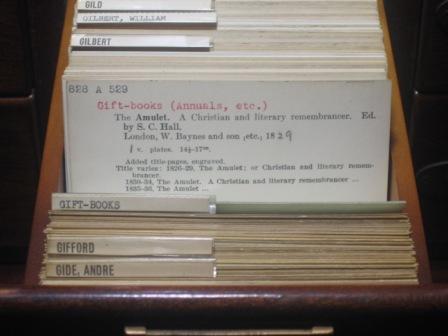 Figure 9. Dewey cards for “gift books.”
Figure 9. Dewey cards for “gift books.”
¶ 51 Leave a comment on paragraph 51 0 In place of perfect and commensurate description—not possible—what we have are cataloguing systems that indexically represent collections through data and metadata that are, as I have already suggested, historically marked and inevitably inconsistent. In the case of the Peabody, these records are further compromised: Dewey cards developed from a nineteenth-century print index do not offer Library of Congress subject terms or detailed tables of contents; they also frequently lack other kinds of information.37 (See Figure 9.) My search for “gift book” will turn up bequests—the term “gift book” is often attached to these donations—and it will miss many of the nineteenth-century gift books and annuals in our collection whose records lack subject classifications, or whose subject classifications reference the book’s contents, not its format. For example, the 1848 Rough and Ready Annual: or, Military Souvenir published by Appleton’s has been assigned the subject “Mexican War, 1846-1848—Anecdotes.”38
¶ 52 Leave a comment on paragraph 52 0 The problem of finding is perhaps only a sub-set of the problem of description, but I want to give it special attention because it introduces another variable: the physical space of the object. My search for gift books in the Peabody also entails the privilege of retrieving the books from the stacks. There are two search processes, the intellectual and the physical, that I must navigate. The intellectual search in this case requires a variety of keyword/date range combinations, and ultimately, recourse to my prepared bibliography—a holdover from pre-catalogue research methods. Now the second search begins.
¶ 53
Leave a comment on paragraph 53 0
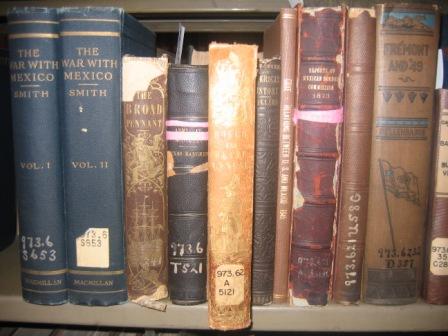 Figure 10. The Rough and Ready Annual in the stacks.
Figure 10. The Rough and Ready Annual in the stacks.
¶ 54 Leave a comment on paragraph 54 0 The Rough and Ready Annual is at 973.62 A5121, in the “general history of North America; United States” category. (See Figure 10.) This call number range is on the second floor, west side. Other items on my list are in very different parts of the library. Orange Blossoms: A Gift Book for All Who Have Worn, Are Wearing, Or are Likely to Wear Them, edited by the temperance writer T. S. Arthur and published in London, has been given the call number 813 A7910 duodecimo—fourth floor east, in the “American literature in English, fiction” section.39 (See Figure 11.) Arthur shows up again as co-editor of The Baltimore Book: A Christmas and New-Year’s Present, which has received more extensive description as it contains the first printing of Edgar Allan Poe’s short story “Siope.”40 We have two copies of this very genteel little gift book, one at 808.83 B2175 (rhetoric & collections of literature), and one at 810.8 C297 (American literature in English). The New Casket: A Gift Book for All Seasons is in the rare book room at the south end of the third floor.41 (See Figure 12.) In this case, the book’s rarity has to do with a lovely fore-edge painting. It has been assigned to 820.8 N42017 (general books about literature). On the other end of the “rare” continuum is The Family Circle and Parlor Annual, volume 5 in a series, which is shelved up on the sixth floor with the periodicals at 051 F198 (serials in American English).42 (See Figure 13.)
¶ 55
Leave a comment on paragraph 55 0
 Figure 11. Orange Blossoms in the stacks.
Figure 11. Orange Blossoms in the stacks.
¶ 56
Leave a comment on paragraph 56 0
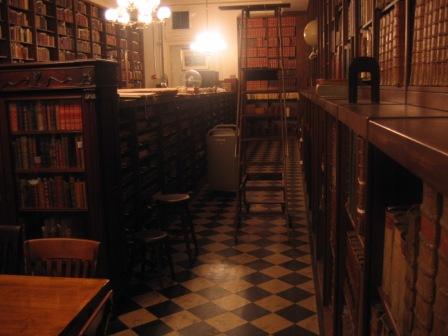 Figure 12. The rare book room.
Figure 12. The rare book room.
¶ 57
Leave a comment on paragraph 57 0
 Figure 13. The Parlor Annual in the stacks.
Figure 13. The Parlor Annual in the stacks.
¶ 58
Leave a comment on paragraph 58 0
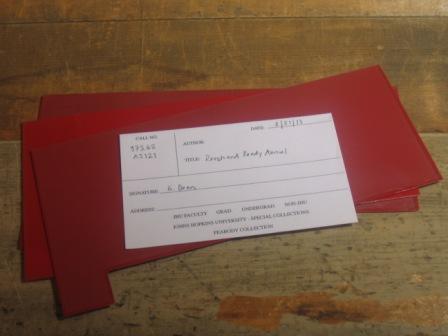 Figure 14. Call slips and flags.
Figure 14. Call slips and flags.
¶ 59 Leave a comment on paragraph 59 0 I’ll fill out call slips for each book, stick the slips into red flags, and put the flags in an order that will help me chart a logical course through the stacks. (See Figure 14.) It’s easiest to start on the sixth floor and work one’s way down, picking up books along the way. Usually I find other interesting items as I go, so I carry a batch of blank call slips and extra flags. (On this occasion, for example, I find The New American Reader: Containing Choice Pieces, in Prose and Verse; published in 1813 and inscribed by its owner in 1817, it pre-dates by several years the official beginning of the gift book phenomenon. It might be more of a “literary almanac.”43 (See Figure 15.) Usually I am also unable to locate at least one of the books I have set out to find. Most likely the book has been misshelved, so I’ll check the quartos and folios, which are shelved separately; then I’ll check the rare book room’s octavo, duodecimo and quarto shelving areas. It used to astonish me that books were still shelved by format in the Peabody, but it does save space. At the same time, this shelving system—along with the multiple distinct areas within the library where books may reside, eg the rare book room, the reference section, the genealogy books, the Limited Editions Club, and several discrete named collections—means that retrieving a few books can take quite a long time, as I traipse up and down the six floors of the library, thread through stacks, open secured doors with multiple keys, turn lights on and off, and maneuver a book truck in and out of a tiny service elevator built in the 1920s. By the end of the journey, the library and I will have exchanged dust; I’ll take on a few streaks of red rot, and the library will have taken in particles from my body as well.
¶ 60
Leave a comment on paragraph 60 0
 Figure 15. Inscription in The New American Reader.
Figure 15. Inscription in The New American Reader.
¶ 61 Leave a comment on paragraph 61 0 While the Peabody is unique, these conditions are not in the end very unusual. In terms of the intellectual search, the absence of “gift book” from many of the catalogue records is no less egregious than the absence of other information—the names of all the contributors; the subjects of the illustrations. The metadata is potentially infinite. The “gift book” only exists as a category because of scholars who teased out this cultural phenomenon; it would be very difficult to define its absolute borders. In terms of the physical search, the Peabody might be messier than, say, a rare book library that has assigned current LC call numbers to all its contents and houses them in compact shelving, but it exemplifies the general on-the-ground situation. As I wind my way through the Peabody stacks, I remember how much more difficult it is to gather research materials from several different institutions.
¶ 62 Leave a comment on paragraph 62 0 The fact is, for scholars who rely on archives, research is something you do only after you have already undertaken a rigorous search. It is the search that provides you with the foundational sense of your subject. But the search is rarely acknowledged or accredited; even the foot-soldier craft of bibliography, the link between “librarianship” and “scholarship,” has largely lost its scholarly status.
¶ 63 Leave a comment on paragraph 63 0 3. An Architecture of Disctinction.
¶ 64 Leave a comment on paragraph 64 0 A non-affiliate researcher contacts the Peabody about our H. L. Mencken collections. Since she will bring a couple of graduate students with her, I set up a group work space in one of the library alcoves where the three of them can share materials and talk without disturbing other readers. I pull the requested volumes with the help of some students and set the cart up within easy reach of the alcove. When the researchers arrive, I show them the Mencken collections on the ground floor. Then I lead them to their group work space and leave them, returning to the glassed-in office behind the reading room, the vantage point that allows me to monitor the otherwise empty reading room.
¶ 65 Leave a comment on paragraph 65 0 In “The Silence of the Library: Environment, Situational Norm, and Social Behavior,” a team of Dutch sociologists investigates the library as a space that is strongly marked by situational norms—“knowledge-based beliefs about how to behave in particular situations that are shaped by social influence.”44 Their research leads them to argue, however, that such norms do not require direct social influences to be triggered; in fact, “the situation can activate mental representations of normative behaviors automatically. And once activated, these representations provide the knowledge necessary for guiding one’s own situationally appropriate behavior.”45 Physical environments do not necessarily prompt these behaviors; rather, the behavior “depend[s] on whether the environment is of immediate behavioral relevance.”46 Talking in a quiet voice in the library, a normative behavior, is only activated for those who plan to visit the library.
¶ 66 Leave a comment on paragraph 66 0 Ten years ago, when the research for this article was conducted, the “silence of the library” was still a widespread norm. While the situation is now often reversed—in our main campus library, we must designate specific quiet areas because otherwise a sociable undergraduate din would take over—the norm of silence does continue to preside at the Peabody. Because it is off campus, the Peabody is often attractively under-populated compared to the crowded main library; it is mostly used by advanced researchers and those who seek a quiet place to study. The large central open area catches and amplifies even the smallest noises. The shelf-lined alcoves on either side of this central area offer the appearance of privacy, but in fact are little echo chambers. Visitors immediately detect these acoustics, and—except for the periodic tour groups—most spend their time in the Peabody in silence. But it is not just the physics of sound that shape behaviors here, as the Dutch researchers show; the social expectations of the space prefigure those behaviors.
¶ 67 Leave a comment on paragraph 67 0 In setting up a group work space for the Mencken researchers, I have quite deliberately contravened the usual norm of silence. Clearly, I am not inviting them to shout, and by putting them in an alcove in back, I have taken measures to protect any quiet-seeking visitors who might arrive. But in accordance with new ideas about the use of library space, my colleagues and I have decided that we must accommodate group study even if it might occasionally disrupt the silence desired by others. As it happens, the Mencken researchers’ conversation is eventually interrupted by a tour group, and the two activities play out side by side.
¶ 68 Leave a comment on paragraph 68 0 I must admit that at moments I have mixed feelings about the tour groups and even the study cohorts. While my pedagogical instincts tend towards cheerful hub-bub, there is a part of me that is still in awe of the sanctuary-like atmosphere of the Peabody. John Morris called the library a “cathedral of books,” and clearly that’s what architect Edmund G. Lind had in mind. The central area with its grand skylight and the alcoves on its sides is like a nave bordered with chapels. Lind didn’t need a psychological study of environment-based situational norms to tell him that he might activate different behaviors within his building. The great central space inspires reverence—your eye is drawn to the skylight the way it would be drawn to the rose windows of Chartres, and on its way up catches row upon solemn row of books stowed behind gilded railings, a testament to the accumulated wisdom of the ages. (See Figure 16.) But step into an alcove, especially on the ground floor where each is filled with an immense wooden table, and you instantly feel something else, something no less grand but more human. The alcoves are study-sized, and once you sit down at one of those dark, gleaming, broad tables, it is like you are the master of your own private library. (See Figure 17.)
¶ 69
Leave a comment on paragraph 69 0
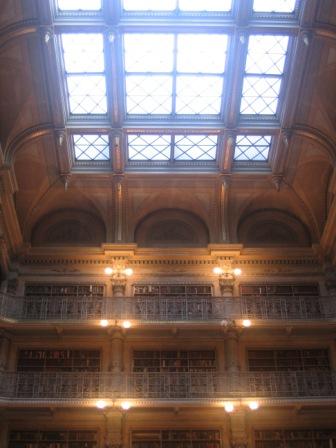 Figure 16. The skylight in the George Peabody Library.
Figure 16. The skylight in the George Peabody Library.
¶ 70
Leave a comment on paragraph 70 0
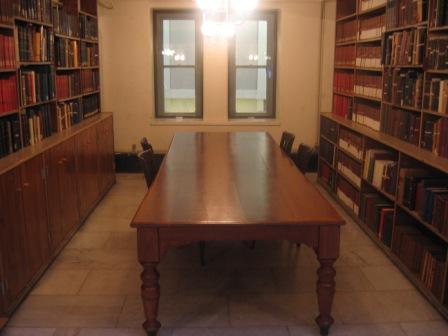 Figure 17. Alcove in the George Peabody Library.
Figure 17. Alcove in the George Peabody Library.
¶ 71 Leave a comment on paragraph 71 0 Ironically, the Peabody’s architecture was out-dated by the time it was completed. With the professionalization of librarianship and the evolution of library science in the late nineteenth century, librarians like William Frederick Poole advocated for a functional rather than decorative design of interior library space.47 Moreover, the actual use of space in the Peabody in the late nineteenth century was at odds with its symbolic appeal. The main library was known as the “stack room”; readers were seated in a comparatively plain reading room on the other side of the main doors. In this arrangement, the librarians reigned inside the gorgeous “cathedral of books,” but the building’s potential to civilize the masses was lost.
¶ 72
Leave a comment on paragraph 72 0
 Figure 18. Photography station in the George Peabody Library.
Figure 18. Photography station in the George Peabody Library.
¶ 73 Leave a comment on paragraph 73 0 Now, of course, we do not send readers outside. Inside the “stack room,” we explicitly call visitors’ attention to its beauty to explain the connections between the library’s architecture and its collections—how both speak eloquently of Victorian values. At the same time, we who staff the library have relegated ourselves to its periphery. We work in the glassed-in room at one end that serves as a monitoring point and occasional classroom; the official “librarian’s office” in one corner—its luxurious proportions suggesting something like a sacristy and something like a robber baron’s lair—is now shared work-space stuffed with several desks and laden book trucks. There is another monitoring station near the main doors. I often do my work at the photography station, in the back of one of the alcoves. (See Figure 18.) It offers some privacy but is close enough to the central reading tables to be accessible to readers.
¶ 74 Leave a comment on paragraph 74 0 The space of the Peabody initiates other situational behaviors besides the norm of silence, and our work-station arrangements testify to this. The spatial re-centralizing of readers and marginalization of staff is not merely practical; it is a reflection of the modern office of librarianship. We are there to be of service, in a para-textual position. Consequently, our work should be out of sight; it should be separate from and secondary to the work that readers do. Our locations call upon us, in other words, to support the scholar’s effort to hide the “seams of [her] findings” by hiding the ways we contribute to that work—by the ways we sometimes do that work.
¶ 75 Leave a comment on paragraph 75 0 I think about these complications as I escort the Mencken researchers to their table and walk back to the glassed-in office, where there is nothing pressing for me to do. I’d rather spend more time talking with them. I’d like to learn about their research and introduce them to some underappreciated parts of the collection. I’d like to share with them what I learned curating an exhibition of Mencken-related magazines and writing about one of those magazines. But I don’t want to get in their way; it’s likely that they are ready to get on with work that they don’t see as connected to mine. The professional norms of the archive are strong, and although I know how to talk about my research in many contexts—in presentations, interviews, hotel elevators—I haven’t figured out how to mix my scholarly role with the curatorial role I am supposed to play here, in the Peabody. In the end, I say nothing. Professional segregation is another kind of silence in the library.
¶ 76 Leave a comment on paragraph 76 0 We cannot change the archaeological record beneath our feet, but we can rearrange the fossils we dig up to create new narratives. We can tell different kinds of archive stories, including the story of what research in the archive was and is. Is it too idealistic to expect that dissolving the entrenched fantasies about archival research will make room for new methods? Is it naïve to imagine a space that, in putting into practice the archival turn’s preliminary insights about disciplinary and disorder, can support experimentation, facilitate connection across professions and disciplines, and enable new discoveries?
¶ 77 Leave a comment on paragraph 77 0
- ¶ 78 Leave a comment on paragraph 78 0
- See Jerome McGann, A Critique of Modern Textual Criticism (Chicago: University of Chicago Press, 1983) on the idea of social authorship, which could be described as “the dialectic between the historically located individual author and the historically developed institutions of literary production” that help create a work, e.g., printers, publishers, editors and readers (81). [↩]
- Alice Yaeger Kaplan, “Working in the Archives,” Yale French Studies 77 (1990): 103-116; 103, 107. [↩]
- See, for example, James M. O’Toole and Richard J. Cox, Understanding Archives and Manuscripts (Chicago: Society of American Archivists, 2006). [↩]
- Antoinette Burton, “Introduction: Archive Fever, Archive Stories,” Archive Stories: Facts, Fictions, and the Writing of History, ed. Burton (Durham: Duke University Press, 2005), 7-8. [↩]
- Burton, 8. Burton notes that “whether historians concede or fully countenance the impact of such contingencies on their work is another question. They rarely speak of them, and even more rarely do they do so in print” (8). Her books recuperates some of those archive stories but this effort, I’ll suggest below, is hampered by other kinds of obligations. [↩]
- Jacques Derrida, “Archive Fever: A Freudian Impression,” Diacritics 25.2 (Summer 1995): 9-63. Web. 1 Dec. 2010. Carolyn Steedman, Dust: The Archive and Cultural History (New Brunswick: Rutgers University Press, 2001). [↩]
- Kaplan, 114. [↩]
- See the use of the term in, for example, Carolyn Hamilton et al, eds., Refiguring the Archive (Boston: Kluwer Academic Publishers, 2002), Cheryl Simon, ed., Following the Archival Turn: Photography, the Museum, and the Archive, special issue of Visual Resources: A Journal of Documentation 18.2 (June 2002), and Ann Laura Stoler, Along the Archival Grain: Epistemic Anxieties and Colonial Common Sense (Princeton: Princeton University Press, 2009). This turn is partially construed as a “move from archive-as-source to archive-as-subject,” but also by the earlier metaphorical interest in “the archive” that goes back to the 1980s (Stoler, 44-45) and by Foucauldian descriptions of archives as “‘monuments to particular configurations of power” (Hamilton, qtd. in Burton, 6). [↩]
- Kaplan, 106, 107. [↩]
- Steedman, 3. [↩]
- Kaplan, 107-108. [↩]
- Another chapter invokes Elizabeth Gaskell’s 1848 novel Mary Barton, a third is anchored by W. H. Auden’s poem “Homage to Clio,” and a fourth finds its most eloquent examples in Charles Dickens’ Our Mutual Friend. [↩]
- Steedman, 2. [↩]
- Derrida, 14. [↩]
- Derrida, 23. [↩]
- A short notice called “Priere d’inserer,” published only in the French book version, carried the bulk of an argument for which there was no room in the lecture. Steedman, 7. [↩]
- Kaplan, 116. [↩]
- Kaplan also begins her essay with a brief consideration of the “arche,” the Greek and Latin term for the public records office, which is a major starting point for Derrida. Is he borrowing from her, or is she borrowing from him, given that this sort of etymological investigation was an established signature of Deconstruction? [↩]
- Kaplan, 104. For this reason, perhaps, Kaplan never reveals what she ultimately discovers in her successful search for Celine’s sources. In fact, it’s not entirely clear whether her pre-emptive and truncated treatment of her archive story is deliberate or not. Is this treatment meant to indirectly support her official claim about “results”? Or does the presence of the archive story suggest that telling it is an impulse she can’t quite control? Thanks, Lauren Coats, for helping tease this problem out. [↩]
- Kaplan, 103. [↩]
- Kaplan, 104. [↩]
- Kaplan, 115. [↩]
- Kaplan, 115. [↩]
- Derrida, 19. [↩]
- Kaplan, 113. [↩]
- This interest in the corporeal dimensions and effects of order, its human and non-human components, has in common with their other gestures—an experimental attitude towards conventional disciplinarity and attention to the priority of disorder—the circumstances of the academic humanities in the 1990s. Since the archival turn came out of the ascent of cultural studies and allied intrigues in the 1970s and ‘80s, the circles in the Venn diagram of these ventures will necessarily overlap. We could also say that the archive took off when it did precisely because it made a clever new container for these preoccupations, thick in the humanities atmosphere at the time, where they were distilled and united. [↩]
- “Were the story of how you got the story really to be told inside the book, it would interrupt or complicate the narrative so much that no results could be understood or even perceived. Every story of success in the archives is emotionally charged, for only the most extreme emotions can drive people to the drudgery, to the discomfort, of sitting and sifting through dog-eared documents, manuscripts, microfilms. To reveal those emotions would not only gum up the narrative, it would threaten its credibility, by showing on what thin strands of coincidence, accident, or on what unfair forms of friendship, ownership, geographical proximity, the discoveries were based” (Kaplan, 104). [↩]
- Derrida, unlike Kaplan and Steedman, makes no claims to work inside an actual archive, unless we consider Yerushalmi’s book as a kind of archive. But the fact that the essay was written self-consciously for presentation at the Freud Museum suggests that it was made out of an archive indirectly—in its construction, if not in its contents. [↩]
- Perhaps this is also the moment to ask why we—I—have been using the term “archive” all along, with its statist resonances, rather than the term “collection,” which has institutional but also personal resonances. Does “archive” bring us closer to recognizably “serious scholarship”? [↩]
- Of course, this is precisely what Derrida meant about the “death drive” of the archival impulse. Archive Stories is something of an exception; researchers speak openly here about themselves as researchers. It is interesting, however, that this book—like Steedman’s—doesn’t cite Kaplan’s essay as a precursor text despite the clear titular link. [↩]
- Alphabetical Catalogue of Books to be Purchased for the Library of the Peabody Institute, Baltimore, Vols. 1 and 2 (Baltimore: John D. Toy, 1861, 1863). [↩]
- The Peabody Institute of the City of Baltimore: The Founder’s Letters and the Papers Relating to its Dedication and History, Up to the 1st January, 1868 (Baltimore: William K. Boyle, 1868); and subsequent Annual Reports, 1869, etc. [↩]
- Catalogue of the Library of the Peabody Institute of the City of Baltimore, Vols. 1-5 (Baltimore: Isaac Friedenwald, 1883; reprinted Boston: G. K. Hall, [1961?]; also on googlebooks), and Second Catalogue of the Library of the Peabody Institute of the City of Baltimore, Including the Additions Made Since 1882, Vols. 1-8 (Baltimore: Deutsch Lithographic and Printing, 1896; reprinted Boston: G. K. Hall, 1961). [↩]
- “Letters from George Peabody, Esq.: Baltimore, February 12th, 1857,” in Founder’s Letters, 7. [↩]
- Qtd. in Franklin Parker and Betty J. Parker, “PIB Ref. Library. 8-Morison’s Philosophy of Excellence,” in George Peabody (1795-1869): A-Z Handbook of the Massachusetts-Born Merchant in the South, London-Based Banker, and Philanthropist’s Life, Influence, and Related People, Places, Events, and Institutions. 11 Mar. 2011. [↩]
- See, for example, Alexis McCrossen, “’One Cathedral More’ or ‘Mere Lounging Places for Bummers’? The Cultural Politics of Leisure and the Public Library in Gilded Age America,” Libraries & Culture 41.2 (2006): 169-188; Paul Sturges, “The Public Library and Reading by the Masses: Historical Perspectives on the USA and Britain 1850-1900,” http://www.ifla.org/IV/ifla60/60-stup.htm; Trustees of the Public Library of the City of Boston, Upon the Objects to be Attained by the Establishment of a Public Library, http://www.mcmillanlibrary.org/history/report_of_trustees.html, 12 Dec. 2010. [↩]
- Many of the electronic records for Peabody books have been copy-cataloged, that is, developed from records for identical books in other libraries. But these records might also be incomplete or inconsistent, given that many are quite old. The expense of original cataloging prevents our staff from creating full, new records for every item in the Peabody’s collection of over 300,000 titles. [↩]
- Rough and Ready Annual (New York: D. Appleton; Philadelphia: G.S. Appleton, 1848). [↩]
- Orange Blossoms: A Gift Book for All Who Have Worn, Are Wearing, Or are Likely to Wear Them (London: Knight & Co., [1857]). This title does not appear in at least one Arthur bibliography; see Donald A Koch, “Timothy Shay Arthur,” Antebellum Writers in New York and the South, ed. Joel Myerson (Detroit: Gale Research, 1979), from Literature Resource Center. Web. 19 Feb. 2011. To check on this, I need Mitchell Sharpe Jr.’s A Bibliography of the Published Books of Timothy Shay Arthur (Atlanta: Emory University, 1954), a typewritten quarto at 012 A791S, but it seems to be missing. [↩]
- The Baltimore Book: A Christmas and New-Year’s Present (Baltimore: Bayly and Burns, [1838]). [↩]
- The New Casket: A Gift Book for All Seasons (London: The Religious Tract Society, ca. 1850). [↩]
- The Family Circle and Parlor Annual (New York: Comstock, 1847). [↩]
- The New American Reader: Containing Choice Pieces, in Prose and Verse (Philadelphia: David Hogan, 1813). [↩]
- Henk Aarts and Ap Dijksterhuis, “The Silence of the Library: Environment, Situational Norm, and Social Behavior,” Journal of Personality and Social Psychology 84.1 (2003), 19. [↩]
- Aarts and Dijksterhuis, 19. [↩]
- Aarts and Dijksterhuis, 20. [↩]
- See William Frederick Poole, Remarks on Library Construction (Chicago: Jansen, McClurg, 1884). [↩]

